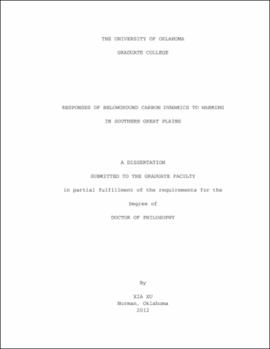| dc.contributor.advisor | Luo, Yiqi | |
| dc.creator | XU, XIA | |
| dc.date.accessioned | 2019-04-27T21:24:11Z | |
| dc.date.available | 2019-04-27T21:24:11Z | |
| dc.date.issued | 2012 | |
| dc.identifier | 99160495002042 | |
| dc.identifier.uri | https://hdl.handle.net/11244/318604 | |
| dc.description.abstract | Compared with research on aboveground carbon (C) processes in grassland ecosystems, little is known on how belowground C processes would respond to projected global warming. In this dissertation, responses of belowground net primary productivity (BNPP) and its partitioning with respect to aboveground NPP (fBNPP), soil organic C (SOC) pools, and the temperature sensitivity of SOC decomposition to warming were studied in a tallgrass prairie in the Southern Great Plains, USA. Infrared heaters were used to elevate soil temperature by approximately 2 oC since November 1999. Annual clipping was nested within warming treatment to mimic hay harvest. In the first study (BNPP, Chapter 2), I examined temporal patterns in responses of BNPP and NPP partitioning to experimental warming and annual clipping from 2005 to 2009. Over the years, warming increased BNPP by an average of 41.89% in the unclipped subplots and 66.93% in the clipped subplots, with significant increase observed in wet years. Clipping also had significant positive impact on BNPP, which was mostly found under warming. Overall, fBNPP, the fraction of BNPP to NPP, increased under both warming and clipping treatments, more in dry years. Water availability (either precipitation or soil moisture) was found to strongly dominate the interannual variability in NPP, fBNPP, and their responses to warming and clipping, suggesting that water availability regulated tallgrass prairie's responses to warming and land use change, which may eventually influence the global C cycle. | |
| dc.description.abstract | In the second study (SOC pools, Chapter 3), the modified potassium permanganate (KMnO4, 0.02 mol L-1) procedure and combustion method were used to estimate chemically labile organic C (LOC) and SOC, respectively, from 2000 to 2008. Warming significantly decreased chemically labile organic C (LOC) by an average of 15.56%, but had little effect on SOC content. A two-stage variation in LOC responses to warming was observed, with no significant changes from 2000 to 2004 and significant decreases from 2005 to 2008. Lagged temporal dynamics of LOC (2 yrs) were asynchronously correlated with warming-increased C4 proportion of aboveground biomass (AGB). These findings suggest that staged decreases in LOC under warming may be related to the increase in C4 biomass through detrital inputs, making it difficult to predict the effect of warming on C cycling in this region. | |
| dc.description.abstract | In the third study (SOC decomposition, Chapter 4), the "C quality-temperature" hypothesis was tested in a 170-day laboratory experiment by incubating soil samples with changing temperature (low-high-low) at a ±5 oC step every 24 hours. I had four treatments of soil samples before lab incubation: control (C), warmed (W), field incubation (FI), and warmed plus field incubation (WFI). Results showed that SOC decomposition rate was positively influenced by LOC content under different treatments and lab incubation cycles. Field warming and field incubation increased the temperature sensitivity of SOC decomposition in the 1st two lab incubation cycles but the treatment effects diminished as decomposition proceeded. Q10 values of SOC decomposition increased with decreasing SOC quality. This relationship held across treatments and lab incubation cycles, regardless of whether the differences in SOC quality resulted from inherent differences in SOC chemistry or from differences in the extent of SOC decomposition. Treatment effects of field warming and field incubation on SOC quality and Q10 values were also negatively correlated with each other. These findings suggest that dynamics of low-quality SOC had the highest potential to impact long-term C stocks in soils, probably resulting in a positive feedback of SOC to climate change in the future. | |
| dc.format.extent | 150 pages | |
| dc.format.medium | application.pdf | |
| dc.language | en_US | |
| dc.relation.requires | Adobe Acrobat Reader | |
| dc.subject | Global warming--Great Plains | |
| dc.subject | Carbon cycle (Biogeochemistry) | |
| dc.subject | Climatic changes--Great Plains | |
| dc.title | Responses of Belowground Carbon Dynamics to Warming in Southern Great Plains | |
| dc.type | text | |
| dc.type | document | |
| dc.thesis.degree | Ph.D. | |
| ou.group | College of Arts and Sciences::Department of Microbiology and Plant Biology | |
